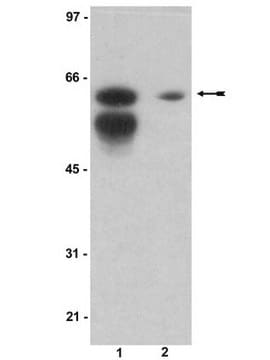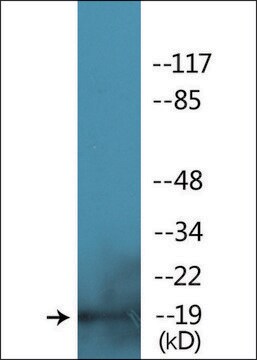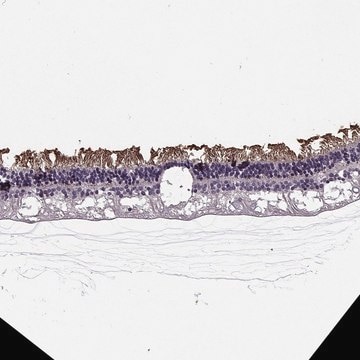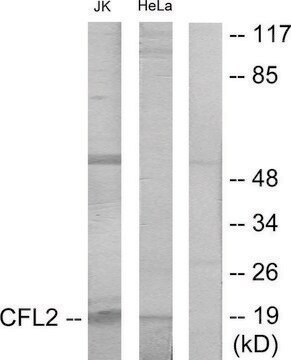07-415-I
Anti-Sam 68 Antibody
serum, from rabbit
Synonym(e):
KH domain-containing, RNA-binding, signal transduction-associated protein 1, GAP-associated tyrosine phosphoprotein p62, Src-associated in mitosis 68 kDa protein, Sam68, p21 Ras GTPase-activating protein-associated p62, p68
About This Item
Empfohlene Produkte
Biologische Quelle
rabbit
Qualitätsniveau
Antikörperform
serum
Antikörper-Produkttyp
primary antibodies
Klon
polyclonal
Speziesreaktivität
human, mouse
Speziesreaktivität (Voraussage durch Homologie)
rat (based on 100% sequence homology)
Methode(n)
immunocytochemistry: suitable
immunohistochemistry: suitable
immunoprecipitation (IP): suitable
western blot: suitable
NCBI-Hinterlegungsnummer
UniProt-Hinterlegungsnummer
Versandbedingung
wet ice
Posttranslationale Modifikation Target
unmodified
Angaben zum Gen
human ... KHDRBS1(10657)
mouse ... Khdrbs1(20218)
rat ... Khdrbs1(117268)
Allgemeine Beschreibung
Spezifität
Immunogen
Anwendung
Zelluläre Signaltransduktion
Signalübertragung & Neurowissenschaft
Immunohistochemistry Analysis: A 1:600 dilution from a representative lot detected Sam 68 in mouse colon tissue (Data courtesy of Stephane Richard, McGill University).
Western Blotting Analysis: A representative lot detected Sam 68 in endogenous Sam 68 and exogenously expressed GFP-Sam 68 fusion in HeLa cells (Chen, T., et al. (1999). Mol Biol Cell. 10(9):3015-3033).
Western Blotting Analysis: A representative lot detected Sam 68 in HEK293 transfected with GFP-Sam68, mouse cortex, hippocampus, cerebellum, and mouse brain (Iijima, T., et al. (2011). Cell. 147(7):1601-1614).
Western Blotting Analysis: A representative lot detected Sam 68 in HeLa cells transfected with GFP-Sam68, MDA-MB-231, MDA-MB-468, and BT20 (Lukong, K.E., et al. (2005). J Biol Chem. 280(46):38639-38647).
Western Blotting Analysis: A representative lot detected Sam 68 in lysates from isolated mouse cells and mouse embryonic cell (Richard, S., et al. (2005). PLoS Genet. 1(6):e47).
Immunohistochemistry Analysis: A representative lot detected Sam 68 in mouse cerebellum, parasagittal section of brain stem and cerebellum (Iijima, T., et al. (2011). Cell. 147(7):1601-1614).
Immunohistochemistry Analysis: A representative lot detected Sam 68 in embryonic mice (Richard, S., et al. (2005). PLoS Genet. 1(6):e47).
Immunocytochemistry Analysis: A representative lot detected Sam 68 in HeLa cells (Chen, T., et al. (1999). Mol Biol Cell. 10(9):3015-3033).
Immunoprecipitation Analysis: A representative lot immunoprecipitated Sam 68 in HeLa, HeLa cells transfected with GFP-Sam68, and MDA-MB-468 (Lukong, K.E., et al. (2005). J Biol Chem. 280(46):38639-38647).
Qualität
Western Blotting Analysis: A 1:500 dilution of this antibody detected Sam68 in 10 µg of MDA-MB-468 cell lysate.
Zielbeschreibung
Verlinkung
Physikalische Form
Lagerung und Haltbarkeit
Handling Recommendations: Upon receipt and prior to removing the cap, centrifuge the vial and gently mix the solution. Aliquot into microcentrifuge tubes and store at -20°C. Avoid repeated freeze/thaw cycles, which may damage IgG and affect product performance.
Sonstige Hinweise
Haftungsausschluss
Sie haben nicht das passende Produkt gefunden?
Probieren Sie unser Produkt-Auswahlhilfe. aus.
Lagerklassenschlüssel
10 - Combustible liquids
WGK
WGK 1
Analysenzertifikate (COA)
Suchen Sie nach Analysenzertifikate (COA), indem Sie die Lot-/Chargennummer des Produkts eingeben. Lot- und Chargennummern sind auf dem Produktetikett hinter den Wörtern ‘Lot’ oder ‘Batch’ (Lot oder Charge) zu finden.
Besitzen Sie dieses Produkt bereits?
In der Dokumentenbibliothek finden Sie die Dokumentation zu den Produkten, die Sie kürzlich erworben haben.
Unser Team von Wissenschaftlern verfügt über Erfahrung in allen Forschungsbereichen einschließlich Life Science, Materialwissenschaften, chemischer Synthese, Chromatographie, Analytik und vielen mehr..
Setzen Sie sich mit dem technischen Dienst in Verbindung.







